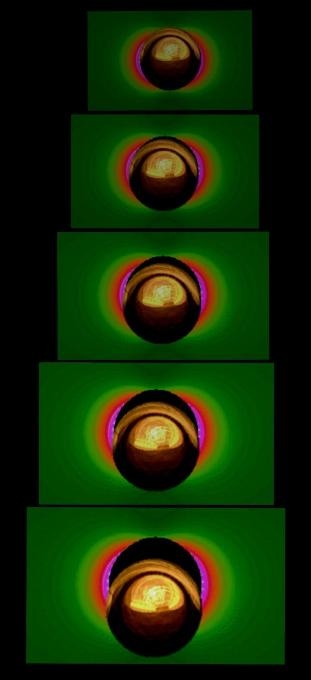Apr 1 2019
Paper-based diagnostic tests are biodegradable, less expensive, and convenient. Still, their application is restricted by traditional dyes that are not sufficiently bright to reveal trace amounts of analyte, can be hazardous to the environment, and are prone to fading.
 Metal nanoparticle concept art. (Image credit: Prof. Eden Morales-Narváez, CIO Mexico)
Metal nanoparticle concept art. (Image credit: Prof. Eden Morales-Narváez, CIO Mexico)
According to a review published in Frontiers in Bioengineering and Biotechnology, currently, scientists are making use of quantum physics to solve these problems. It is possible to capture the strange optical properties of tiny metal particles, which are smaller compared to light waves, on paper to identify even a single target molecule in a test sample. Hyper-sensitive testing devices such as these can be set up and tailored at the point of use in low-resource environments, with almost limitless applications ranging from forensics, medicine, environmental safety, to manufacturing.
A new generation of paper-based analytical devices is being developed, which use metal nanoparticles for analyte identification. These will allow low-cost testing in low-resource settings from clinics to crime scenes to contaminated water sources.
Dr Eden Morales-Narváez, Study Lead Author, Center for Optics Research in Mexico.
Paper-Based Diagnostics are Smart but Not Bright
Paper is a perfect medium for less expensive, accessible diagnostic devices—and has already made its way in the form of pregnancy-test-style strips that just mix a sample with a test chemical.
“Paper devices can filter, concentrate and mix reagents with controlled timing and sequence—by using guidelines that can be scored, drawn or even printed on,” explained Morales-Narváez. “Some groups have even used origami to vary flow direction and add processing steps that allow more sophisticated, duplicate or parallel reactions using a single paper device.”
The real challenge is to read the results of these paper-based tests.
“Test reactions are set up so that if the substance of interest or ‘analyte’—a biomarker or pollutant, for instance—is present in a sample, a colored pigment is produced or altered.”
“The problem is that conventional pigments produce colors by selectively absorbing some wavelengths and simply reflecting others—for example, red ink appears red because it absorbs strongly in the blue and green spectral regions.”
“This means that for a visible color change to occur, relatively large amounts of analyte are required. In other words, the test is not very sensitive.”
Still worse is the fact that it is not possible to save the test result as a record since pigments are prone to fading, and in certain cases cannot be discarded safely due to pigment toxicity.
A Quantum Physics Solution
An ultra-bright color indicator is what is required for paper-based tests. The key to this would be metal nanoparticles (MNPs).
“MNPs are can give a brighter, lasting color signal, since they dramatically amplify a particular wavelength of light—rather than simply reflecting it,” adds Morales-Narváez.
As the name signifies, MNPs are pieces of metal that are nanometer-sized. With a size that is 10–100 times smaller compared to light waves, their behavior belongs to the bizarre realm of quantum physics.
“Put simply: metals consist of a fixed lattice of positive ions, which share a ‘cloud’ of negatively charged free electrons.”
“In nanometer-sized pieces of metal, certain wavelengths of light make these free electrons vibrate with respect to the fixed positive ions in the metal. This vibration amplifies the light, emitting a brighter color.”
If it is still not clear enough, it should be remembered that light is a visible electromagnetic field. Consider a cube of metal positioned inside this field. Since electrons are negatively charged, they will move toward the positive pole of the field, exposing positive metal ions at the negative pole. Upon removing the field, (or is it—the light wave—oscillates) the electrons tend to move in the opposite direction, repelled by one another and attracted back toward the exposed positive metal ions. The electrons oscillate backward and forward in this manner with the change in polarity of the electromagnetic field.
Ultra-Sensitive Paper-Based Diagnostics
Most importantly, the specific wavelength that makes the free electrons to vibrate can be tuned—therefore, the color that the MNPs amplify is dependent on their size, shape, and spacing, and also the type of metal and the surrounding medium.
Consequently, a paper-based test reaction can be coupled to a change in MNP color in different ways.
You can make MNPs that bind the analyte, then let these flow in solution over fixed biorecognition elements on the paper such as antibodies, that also bind the analyte. A positive test will cause the MNPs to accumulate and so change their spacing and surroundings. Alternatively, MNPs can be released from a holding molecule when this reacts with an analyte. Some analytes can even erode MNPs, causing a color change directly. For example, ammonia and other volatile compounds from food spoilage, or UV radiation from sun exposure.
Dr Eden Morales-Narváez, Study Lead Author, Center for Optics Research in Mexico.
The outcome is ultra-sensitive paper diagnostics.
“MNPs can produce visible color changes at even attomolar concentrations of analyte,” confirmed Morales-Narváez.
That is nearly 30 molecules per test sample drop. However, in case the paper test is read by a special machine instead of the human eye, the sensitivity is even higher.
“Combined with a scanning technique called Raman spectroscopy, MNPs can report detection of a single molecule of analyte.”
Since more than 10,000 research articles published in 2018 reported the investigation of the use of MNPs, quantum physics-powered paper diagnostic devices could soon make it to the mainstream.